At 19 years old, Joshua Smith (not his real name) was diagnosed with an opiate use disorder. Following several attempts at treatment, Smith moved from California to a town in Arizona known for being home to recovery houses for those struggling with substance use disorders. Six months after he arrived in Arizona, Smith relapsed and overdosed on heroin.
Local authorities revived Smith, arrested him, and then gave him two options: he could go to jail or he could go into treatment. Smith chose treatment — or at least that’s what he thought. What Smith chose, more specifically, was to go through the alternative sentencing program known as drug court, which allows those who plead guilty to undertake community service and court-supervised treatment instead of going to prison.
When Smith pled guilty to a drug-related felony in October 2016 and was sent to court-supervised treatment, he recognized that he needed additional medical help in overcoming his opiate use disorder. Like many other people with this disorder, however, Smith could not simply quit “cold turkey.” To detox and prevent a relapse, he needed medication-assisted treatment.
But there was a problem: Smith’s drug court program banned participants from trying the medication-assisted approach, even on doctor’s orders. Unable to implement the medication-assisted treatment, Smith relapsed, tested positive for opiates at a screening, and was given a 60-day jail sentence as punishment. When his mother asked the court to reconsider its policy on medication-assisted treatment, she was ordered to refrain from contacting her son and warned that if she didn’t, he could spend more time in jail.
Ever since they were first established in 1989 in Miami, Florida, drug courts have found political supporters on both the right and the left. Both sides want to cut costs, lower incarceration rates, and offer rehabilitation — and proponents of drug courts claim they do all three. It’s unsurprising, then, to find that the drug court model has become wildly popular in the United States. (So much so, in fact, that it’s even become a part of U.S. foreign policy.)
Yet as Smith’s story — and a new report from Physicians for Human Rights — makes all too clear, drug courts are far from perfect. In fact, despite being one of the most heavily studied elements of the U.S. criminal justice system, the efficacy of drug courts is still a topic of intense debate. It’s true, for example, that studies have shown them to be better than prison when it comes to reducing recidivism. But these studies have themselves been contested, with critics arguing that they are poorly designed and fail to compare drug court outcomes with those of voluntary, community-based treatment.
The real question, therefore, is not whether drug courts are better than prisons. It’s whether drug courts represent a truly health-centered policy response to those struggling with substance use disorders. Are drug courts the answer? Or are they merely a stopgap on the road to something better? From a public health and human rights perspective, at least, the answer to that final question is a clear, resounding “yes.”
For a sense of how drug courts fall short of their professed goals, simply consider one of their fundamental tenets: that people with substance use disorders who choose to go into drug court rather than spend years in prison are making a truly voluntary decision. The reality, of course, is much more complicated. By their very design, these courts put defendants in a situation where choosing treatment — regardless of its quality and regardless of their ability to comply with it — is the only way to avoid an official prison sentence, although many, like Smith, still face significant time in jail during the drug court program.
Yet if they agree to undergo treatment through the drug courts, some defendants are still positioned to fail, either because they lack necessities such as housing, food, and transportation, or because they, like Smith, are not allowed to use the best treatment for their specific disorder. Worse still, many drug courts — especially those in rural areas, where access to quality treatment may be scarce — are significantly underfunded and understaffed.
Drug courts are also wildly inconsistent when it comes to providing evidence-based treatment. For example, despite even the National Association of Drug Court Professionals recommending against it, medical professionals are sometimes overruled by probation officers or judges who prefer a less therapeutic approach. “Treatment gets trumped by legal,” as Jessica Stucker, the clinical director for the drug court program in Strafford County, New Hampshire, once said to this author.
To be fair, much of what ails drug courts is a product of larger, structural failures in the U.S. criminal justice and health care systems: the criminalization and routinely severe punishment of drug possession, the lack of health insurance and other ways to pay for quality care, the wariness of prosecutors who fear the political repercussions of being labeled “soft on crime,” and so on. Ultimately, though, supporters of drug courts have a responsibility to engage with their critics, respect international law, and improve.
Back in July of 2015, a now-former director of standards at the National Association for Drug Court Professionals told the magazine Pacific Standard, “Now that we have almost 3,000 drug courts across the country and in every single state, we want a drug court that works in reach of everyone in need.”
By that standard, drug courts in the United States are not “working” — not for people like Smith, not for their communities, and not for the public at large.
Originally published at www.opensocietyfoundations.org.

